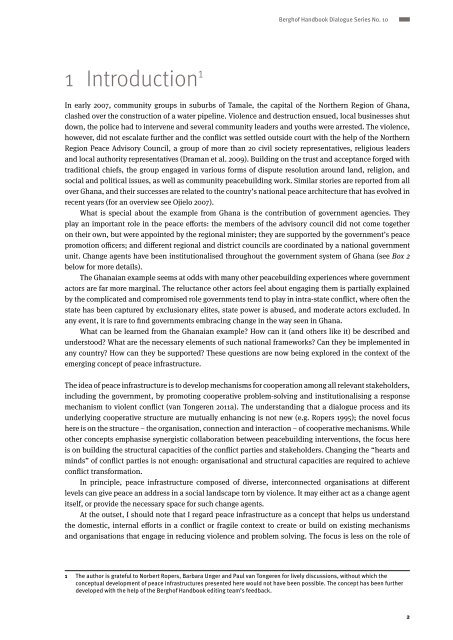Giving Peace an Address? - Berghof Handbook for Conflict ...
Giving Peace an Address? - Berghof Handbook for Conflict ...
Giving Peace an Address? - Berghof Handbook for Conflict ...
You also want an ePaper? Increase the reach of your titles
YUMPU automatically turns print PDFs into web optimized ePapers that Google loves.
1 Introduction 1<br />
<strong>Berghof</strong> H<strong>an</strong>dbook Dialogue Series No. 10<br />
In early 2007, community groups in suburbs of Tamale, the capital of the Northern Region of Gh<strong>an</strong>a,<br />
clashed over the construction of a water pipeline. Violence <strong>an</strong>d destruction ensued, local businesses shut<br />
down, the police had to intervene <strong>an</strong>d several community leaders <strong>an</strong>d youths were arrested. The violence,<br />
however, did not escalate further <strong>an</strong>d the conflict was settled outside court with the help of the Northern<br />
Region <strong>Peace</strong> Advisory Council, a group of more th<strong>an</strong> 20 civil society representatives, religious leaders<br />
<strong>an</strong>d local authority representatives (Dram<strong>an</strong> et al. 2009). Building on the trust <strong>an</strong>d accept<strong>an</strong>ce <strong>for</strong>ged with<br />
traditional chiefs, the group engaged in various <strong>for</strong>ms of dispute resolution around l<strong>an</strong>d, religion, <strong>an</strong>d<br />
social <strong>an</strong>d political issues, as well as community peacebuilding work. Similar stories are reported from all<br />
over Gh<strong>an</strong>a, <strong>an</strong>d their successes are related to the country’s national peace architecture that has evolved in<br />
recent years (<strong>for</strong> <strong>an</strong> overview see Ojielo 2007).<br />
What is special about the example from Gh<strong>an</strong>a is the contribution of government agencies. They<br />
play <strong>an</strong> import<strong>an</strong>t role in the peace ef<strong>for</strong>ts: the members of the advisory council did not come together<br />
on their own, but were appointed by the regional minister; they are supported by the government’s peace<br />
promotion officers; <strong>an</strong>d different regional <strong>an</strong>d district councils are coordinated by a national government<br />
unit. Ch<strong>an</strong>ge agents have been institutionalised throughout the government system of Gh<strong>an</strong>a (see Box 2<br />
below <strong>for</strong> more details).<br />
The Gh<strong>an</strong>ai<strong>an</strong> example seems at odds with m<strong>an</strong>y other peacebuilding experiences where government<br />
actors are far more marginal. The reluct<strong>an</strong>ce other actors feel about engaging them is partially explained<br />
by the complicated <strong>an</strong>d compromised role governments tend to play in intra-state conflict, where often the<br />
state has been captured by exclusionary elites, state power is abused, <strong>an</strong>d moderate actors excluded. In<br />
<strong>an</strong>y event, it is rare to find governments embracing ch<strong>an</strong>ge in the way seen in Gh<strong>an</strong>a.<br />
What c<strong>an</strong> be learned from the Gh<strong>an</strong>ai<strong>an</strong> example? How c<strong>an</strong> it (<strong>an</strong>d others like it) be described <strong>an</strong>d<br />
understood? What are the necessary elements of such national frameworks? C<strong>an</strong> they be implemented in<br />
<strong>an</strong>y country? How c<strong>an</strong> they be supported? These questions are now being explored in the context of the<br />
emerging concept of peace infrastructure.<br />
The idea of peace infrastructure is to develop mech<strong>an</strong>isms <strong>for</strong> cooperation among all relev<strong>an</strong>t stakeholders,<br />
including the government, by promoting cooperative problem-solving <strong>an</strong>d institutionalising a response<br />
mech<strong>an</strong>ism to violent conflict (v<strong>an</strong> Tongeren 2011a). The underst<strong>an</strong>ding that a dialogue process <strong>an</strong>d its<br />
underlying cooperative structure are mutually enh<strong>an</strong>cing is not new (e.g. Ropers 1995); the novel focus<br />
here is on the structure – the org<strong>an</strong>isation, connection <strong>an</strong>d interaction – of cooperative mech<strong>an</strong>isms. While<br />
other concepts emphasise synergistic collaboration between peacebuilding interventions, the focus here<br />
is on building the structural capacities of the conflict parties <strong>an</strong>d stakeholders. Ch<strong>an</strong>ging the “hearts <strong>an</strong>d<br />
minds” of conflict parties is not enough: org<strong>an</strong>isational <strong>an</strong>d structural capacities are required to achieve<br />
conflict tr<strong>an</strong>s<strong>for</strong>mation.<br />
In principle, peace infrastructure composed of diverse, interconnected org<strong>an</strong>isations at different<br />
levels c<strong>an</strong> give peace <strong>an</strong> address in a social l<strong>an</strong>dscape torn by violence. It may either act as a ch<strong>an</strong>ge agent<br />
itself, or provide the necessary space <strong>for</strong> such ch<strong>an</strong>ge agents.<br />
At the outset, I should note that I regard peace infrastructure as a concept that helps us underst<strong>an</strong>d<br />
the domestic, internal ef<strong>for</strong>ts in a conflict or fragile context to create or build on existing mech<strong>an</strong>isms<br />
<strong>an</strong>d org<strong>an</strong>isations that engage in reducing violence <strong>an</strong>d problem solving. The focus is less on the role of<br />
1 The author is grateful to Norbert Ropers, Barbara Unger <strong>an</strong>d Paul v<strong>an</strong> Tongeren <strong>for</strong> lively discussions, without which the<br />
conceptual development of peace infrastructures presented here would not have been possible. The concept has been further<br />
developed with the help of the <strong>Berghof</strong> H<strong>an</strong>dbook editing team’s feedback.<br />
2
















